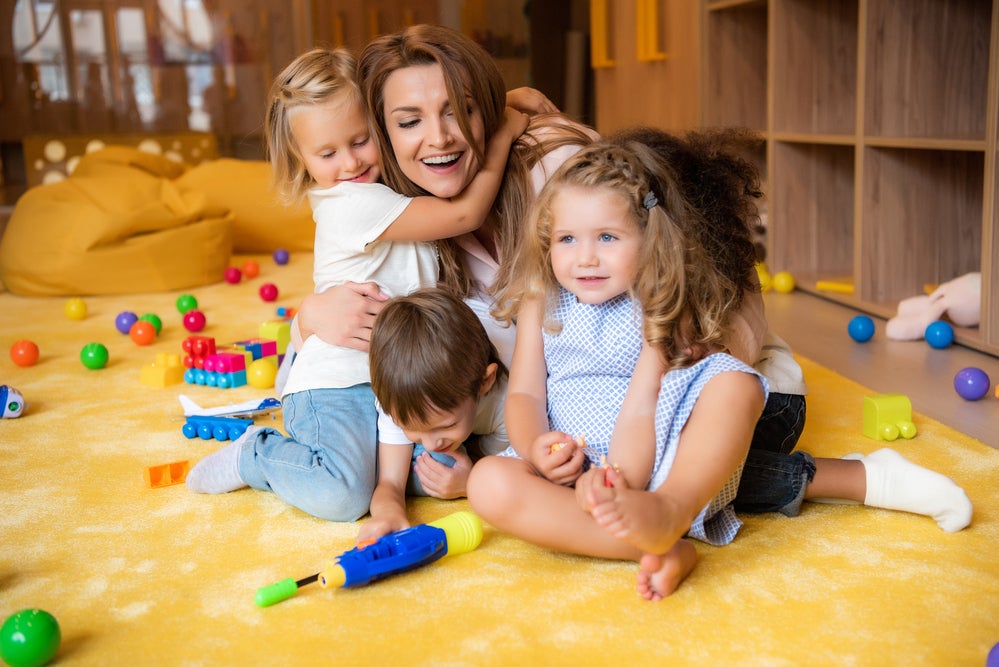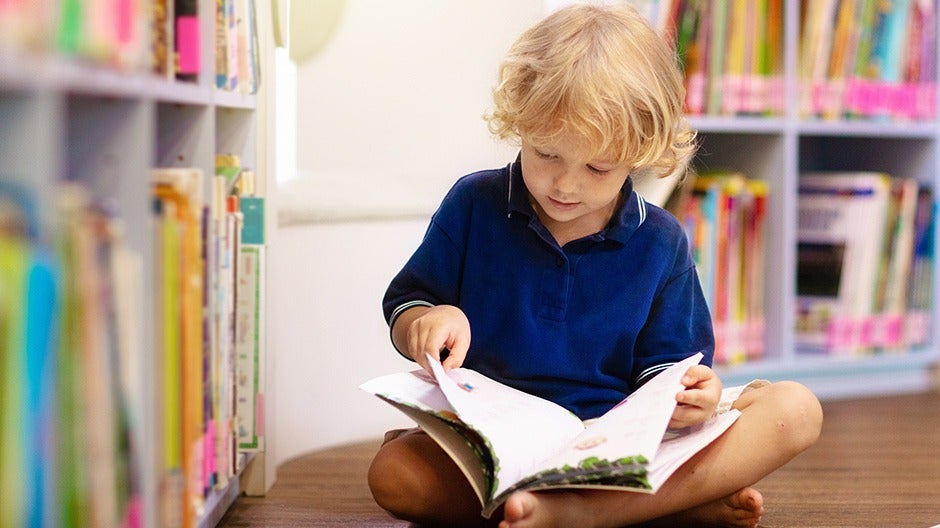Understanding feelings lays the groundwork for kids to develop Character, one of the 5 C’s at the heart of the Begin Approach to helping kids thrive in school and life. Kids with well-developed Character skills tend to be calmer and more emotionally resilient, do better in school, and have healthier relationships with peers and teachers.
But that doesn’t mean that teaching feelings to kids needs to be work! Kids learn best through play, and there are many easy ways to teach feelings to kids through daily activities you’re already doing. Read on to see which ones our learning experts recommend.
The Short Cut
- Learning about feelings helps kids develop Character, one of the 5 C’s that helps them thrive in school and life
- Kids can explore emotions by examining their own feelings, observing the feelings of others, role-playing feelings during pretend play, and reading books or playing games about feelings
- Parents can help teach feelings to kids by talking about feelings in their day-to-day lives, praising kids for talking about feelings, and working fun games about feelings into playtime
7 Strategies to Teach Kids about Feelings

Talking about feelings doesn’t have to mean taking out a special book from the library or playing a game about emotions. Discussing feelings during everyday activities gives your child a way to learn whenever it feels right, and to realize that feelings are always happening.
Here are some of our favorite strategies for teaching feelings throughout the day.
1. Talk about Feelings in Media
Almost every piece of media your child consumes showcases feelings and conversations about them, which makes them great source material for learning!
During films, TV shows, or while reading, pause to ask your child how they think characters feel. Propose different scenarios and discuss how those situations would impact feelings.
For example, if a character in a book was riding a bike, then fell and scraped their knee, you could ask your child to describe how they think the character felt at that moment. Talk about both what they felt and why they felt it.
2. Acknowledge Your Child’s Feelings
Managing so many feelings in one little body can get overwhelming sometimes (we know we’ve been there)! Part of teaching your child about feelings includes teaching them that feelings are perfectly normal.
This goes for positive and negative emotions. The best way to validate your child’s experience and feelings is to acknowledge them!
For example, if you watch a movie together that your child really loved, you could say, “Wow, I think that movie made you really happy because you laughed so much. What was your favorite part?”
We know there will also be times when your child’s feelings of frustration can overwhelm them. If you notice them having a hard time, you could say, “You seem upset because you missed talking to Grandma today. I understand. What can we do to help you feel better?”
This open communication helps your child feel safe, heard, and reassured that their feelings matter.
3. Share Your Feelings and Memories
Emotions are closely linked with memory. Sometimes, playing with your child or doing everyday things at home together may stir up some childhood memories of your own.
This is great, and it’s a wonderful way to bond with your child and teach them more about feelings!
When you and your child are doing things together, share a memory of when you did something similar as a child.
For example, when eating, you could comment on how certain foods make you feel. “Your grandmother used to make this soup for me when I was sick, so it makes me feel happy, warm, and cared for.”
You can also make this about how you feel in the moment. The point is to acknowledge your feelings honestly and openly with your child so they may learn to do the same.
Maybe you got snippy with your child while speaking earlier and want to apologize. This is a wonderful teaching (and bonding) moment.
You could approach them and say, “I’m sorry I got upset earlier. I am really sad Grandma isn’t here today, and I miss her a lot. I think that’s why I was in a bad mood earlier. I hope you forgive me.”
This shows your child several things:
- You acknowledge and respect their emotions
- You accept responsibility for causing someone else pain
- You acknowledge and respect your emotions
- You know it is important to communicate your feelings
These are all invaluable lessons for kids to learn!
4. Use Puppets or Toys to Act Out Emotions
Sometimes talking about feelings can feel like an interrogation, especially for children who are on the shyer side. This is where puppet play can come in handy.
If you find yourself needing to discuss emotions during the day (for example, if your child seems upset after school) but your child doesn’t want to open up, try using puppets to uncover more about what your kid is feeling. Together you can act out different scenarios and discuss why the puppets might react in specific ways based on the circumstances.
If you think something may be bothering your child, you can use puppets as an indirect, safe mode of conversation. Play is a safe place to try out reactions, behaviors, and words that may not be safe (or viewed as appropriate) in the real world.
You might even find that your child is more comfortable presenting their emotions through a puppet character rather than direct communication. This can be especially true if the puppet character wants to do something the child knows they shouldn’t do, like lash out in anger.
This is perfectly OK! It helps you learn more about your child’s emotions, lets you reassure them that all feelings are valid, and gives you a chance to model healthy ways to express feelings.
5. Praise Emotional Language
When your child successfully and accurately describes feelings, give them lots of positive affirmation. This applies to both their own emotions and understanding the emotions of others.
6. Teach Healthy Emotional Expression
Learning how to identify emotions is one thing, but how do children learn exactly how to communicate their feelings? This is where “I feel” statements are beneficial.
Teach your child that when they want to speak up about their emotions, they can start by saying, “I feel …” and filling in the blanks. This way, whoever is listening knows they are about to receive important emotional information.
When your child’s emotions are more intense and conversation isn’t the most accessible tool for them at the moment, encourage them to practice mindfulness techniques and self-soothing actions.
These techniques teach them to pay attention to their body and slowly release powerful emotions. They include:
- Cuddling with something soft in a quiet room
- Playing with tactile items like Play-Doh
- Taking deep, “square” breaths (inhale, hold, exhale, rest)
Don’t be afraid to model yourself as an example! Saying “Wow, I am frustrated about that. I want to calm down,” and modeling deep breaths can be a powerful way to show kids how to work through their own emotions.
Parents with healthy emotional expressions can teach their children firsthand that feelings are natural, powerful, and an important part of the human experience at any age.
Now that we’ve looked at the importance of teaching feelings to kids, let’s get into some effective activities you can use to practice identifying these emotions at home.
5 Activities to Teach Feelings
1. Story Stones

What You’ll Need:
- Rocks
- Acrylic paint (or sharpies)
What to Do:
The goal of this activity is simple: Use the paint to give each of the rocks a different facial expression!
For example, your child could draw one rock smiling, one with a sad mouth, another one with a silly tongue sticking out, and another with a big surprised face!
Once your child has finished their masterpieces, allow the paint to dry and then take a moment to talk about the emotions on the stones. You can even have them pick up each stone and mimic the face they see while identifying the represented emotion.
Walk them through this activity by using easy-to-understand language and your own examples, such as:
This stone shows crying eyes. This stone is sad. I was sad when we moved houses because I loved our previous home. When I’m sad, I sometimes cry and feel down. Do you ever get sad?
This is a great way to give your child a visual representation of different emotions and encourages them to share when they may have felt that way. You can even keep the stones and refer to them (“Do you feel like this stone?”) at times when your child doesn’t want to talk about their feelings.
2. Paper Plate Emotion Masks
What You’ll Need:
- Paper plates
- Scissors
- A sharpie
- Popsicle sticks (or tongue depressors)
- Clear tape
What to Do:
Start by cutting your paper plates in half. Then, write different emotions on the back of each plate (e.g., happy, angry, silly, sad, etc.). For younger children who are just beginning to read, you can assist them with reading each word as you go.
On the front of the paper plates, create a face that represents that feeling. For example, if the mask has “sad” written on the back, then the drawing can be a frown.
After making each face, hold the paper plates up one at a time and talk about what each of these emotions means. Again, make sure to use real-life, easy-to-understand examples so your child can grasp the concepts.
The last step is to tape popsicle sticks onto the back of the paper plates so that you have emotion masks. Your child can then share their own examples of each emotion while holding up the correct face.
Similar to Story Stones, Paper Plate Emotion Masks are an excellent way to teach and discuss feelings with children visually. It’s also hands-on, which allows kids to be fully engaged as they learn about self-expression.
3. Emotional Charades
What You’ll Need:
- Small pieces of paper
- A marker
- A hat (or small bag)
What to Do:
As the name suggests, this activity is all about playing charades with emotions as the clues.
Start by writing different emotions on your pieces of paper, then fold and place them in a hat or bag. Next, have the first player pick one slip of paper, read it quickly to themselves, and act out that feeling. The other players then need to guess which emotion is being portrayed.
This activity is a fun way to introduce emotions to kids in a lighthearted manner. It also helps children grasp that one emotion can be expressed in different ways. For example, if the clue is “sad,” the person acting it out can have a sad face, or they can pretend to cry.
Tip: If your child hasn’t learned how to read yet, you can draw a simple image of the emotion under the word on each piece of paper to help them out.
If you have enough players, this can also be a great game to play with teams. The first team to get five points wins!
4. Emotional Musical Chairs
What You’ll Need:
- Chairs
- Music
- Index cards
- A marker
What to Do:
Musical chairs is a common game that brings lots of fun and laughter. If you’re not familiar with it, here’s a brief explanation:
Players start by standing around a circle of chairs. There should be one chair less than the number of players participating. For example, if there are five players, there should be four chairs.
When the music starts playing, the players walk around the perimeter of the chair circle. Once the music stops, each player rushes to find a chair to sit in, and the player left standing is out!
After this first round, remove another chair and continue repeating this pattern until you have a winner (one person left).
Emotional Musical Chairs is similar, except that each chair has a different emotion written on an index card attached to it. The number of chairs is equal to the people participating, which means that when the music stops, everyone will find a chair, and no one is out.
Here’s how emotional music chairs works:
- Players gather in a circle around the chairs marked with different emotions
- When the music starts, they start walking around the perimeter of the circle
- When the music stops, players quickly find a seat
- Each player then reads the emotion card they’re sitting on and shares a situation that made them feel that way. For example, if the emotion is “happy,” the player can say, “I feel happy when it’s Friday because that’s when we get pizza, and I love pizza!”
Using this fun activity, children get to share their understanding of each emotion while also moving around and burning off energy. It’s a great way to talk about feelings without making things awkward or uncomfortable.
5. Playfully Practice Identifying Feelings
It can be hard for young children to identify their own emotions and even harder for them to recognize emotions in others.
To help them learn, you can make a game out of linking vocal tones, facial expressions, and body language to emotional identification.
Experiment by saying sentences with different emotional emphases. Your child will try to pinpoint exactly what emotion you’re trying to convey through a combination of facial expressions, body language, and tone.
For example, you could say, “It’s cold outside” in an animated, angry voice. Then, your child would try to guess your emotion. Repeat the words, but this time change the emotion—be delighted, or nervous, or bored.
Let your child have some fun, too! Encourage them to say something in an emotional voice and let you guess the emotion.
This is a great activity to try while reading, as well. When you read a voice with an expression (“Give me my shoe!” in a loud, angry tone, for instance), ask your child if you had the best voice for the feeling, and then let them try saying what the character said.
The Rewards of Teaching Feelings

Learning to understand and describe emotions takes years, which means teaching feelings to your child will take time, patience, and practice. But the payoff will be monumental to your child’s relationship with you and their friendships with others.
At Begin, we understand the power of teaching feelings to kids. The first stage of our learning membership, developed with the experts at Sesame Workshop, focuses on it (as well as other Character skills). Kids learn to identify emotions, techniques for managing big feelings, and more, all with the help of their favorite Sesame Street friends.
Take our quiz to see which membership stage is right for your family today!













